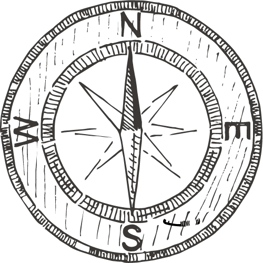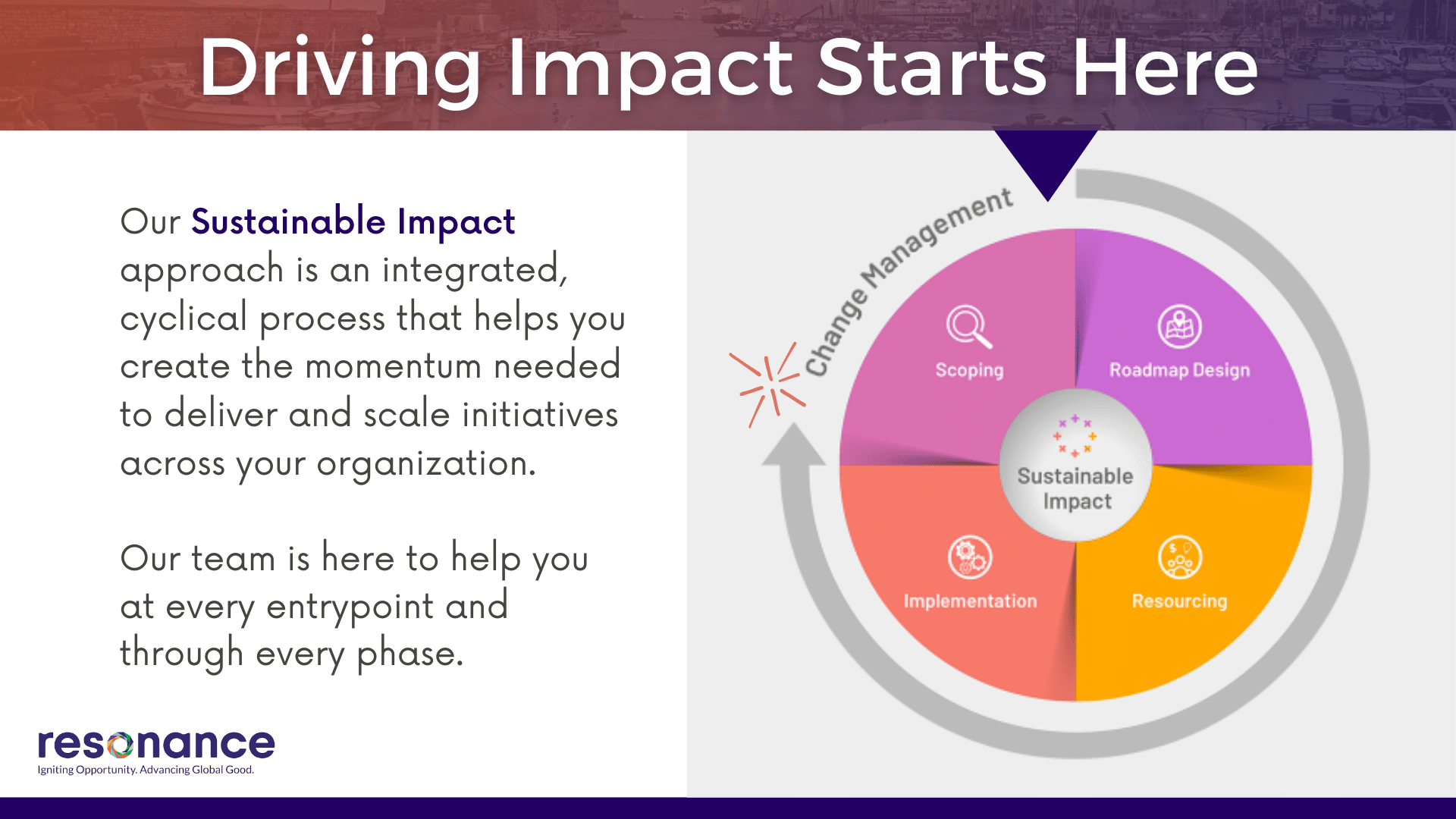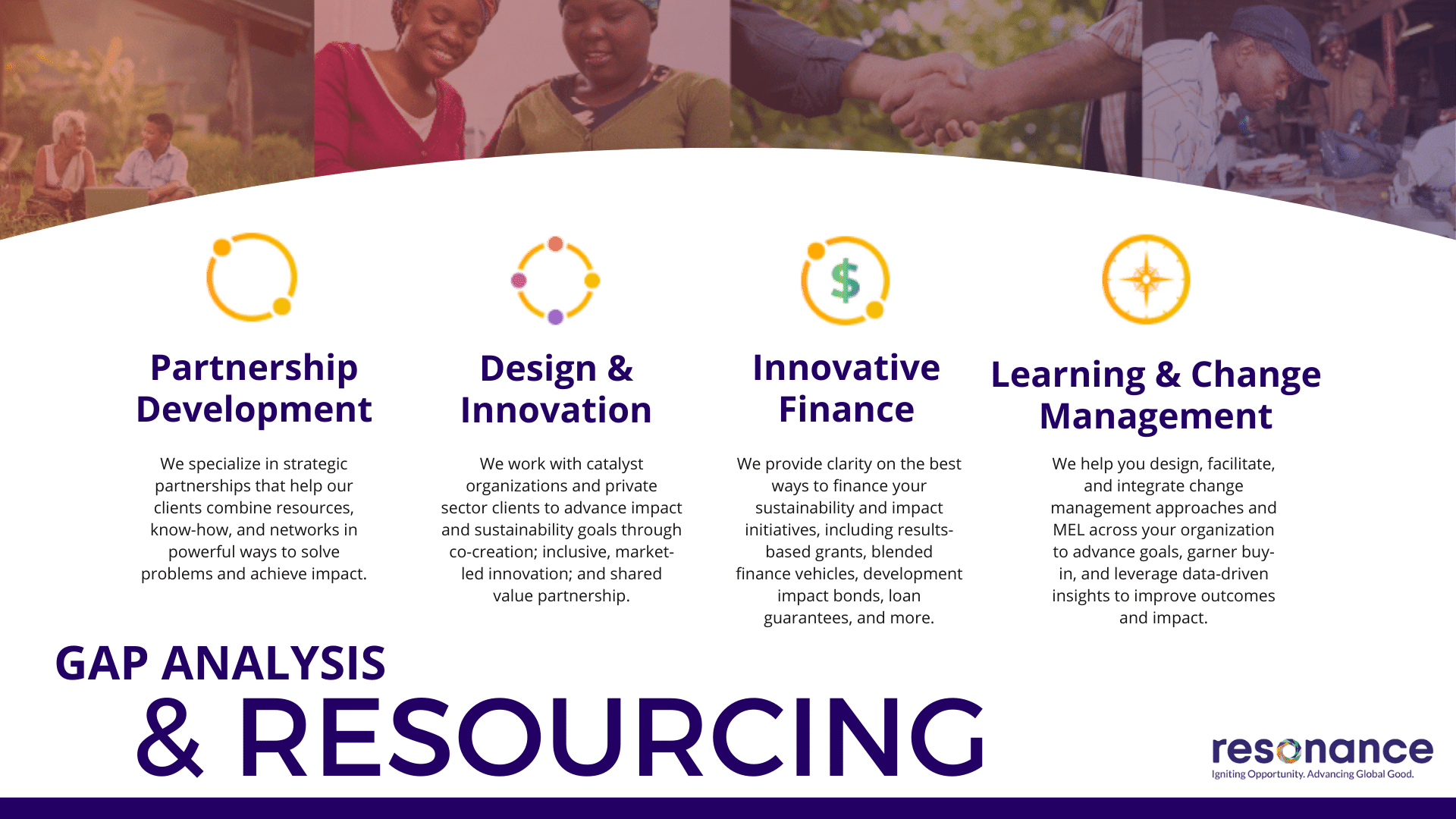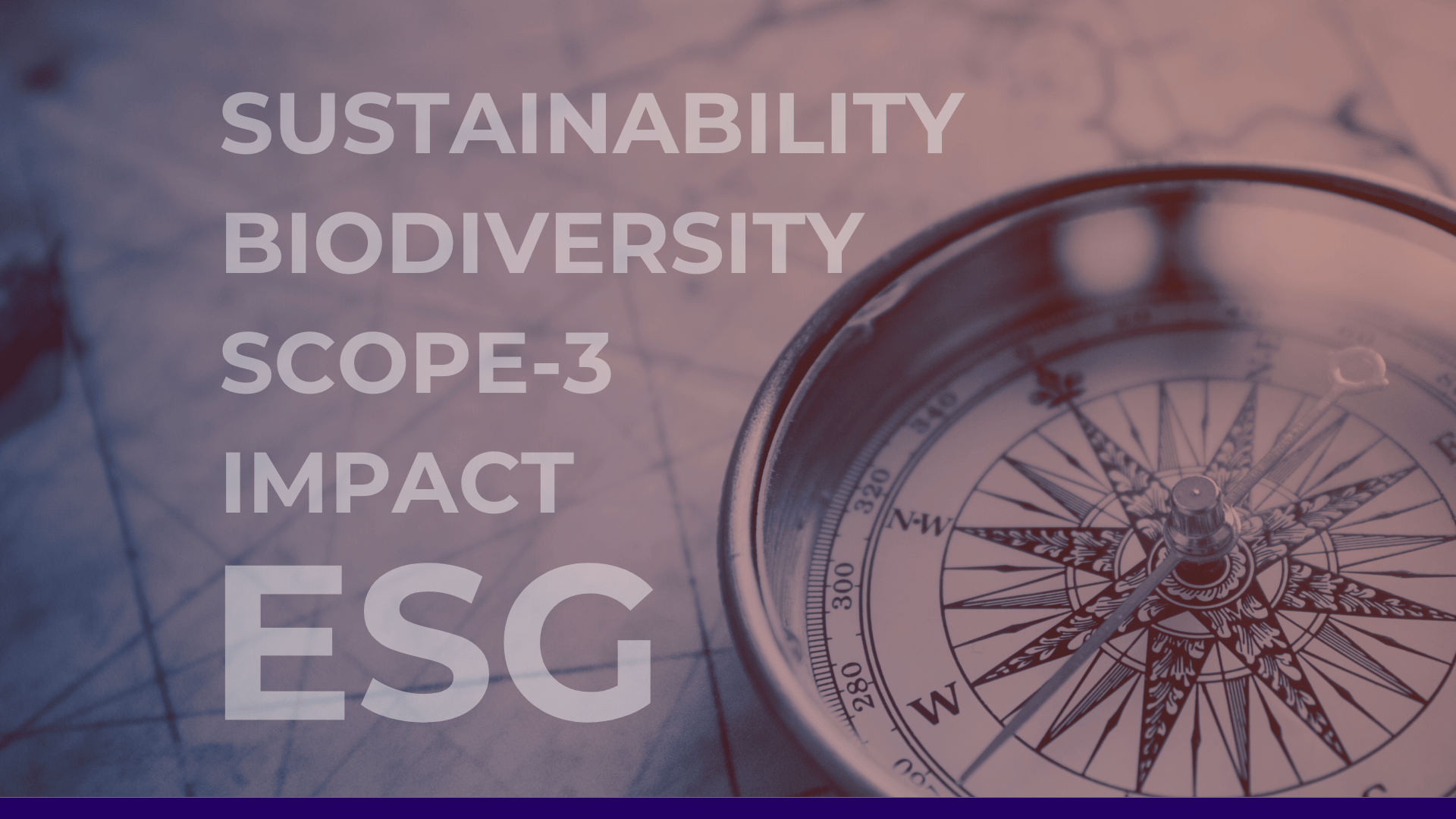An avid enthusiast and champion of Monitoring, Learning, and Evaluation (MEL) on LinkedIn, with a dedicated following (including us) for his regularly published content and resources, was recently met with a reader comment on one of his posts about ‘Theory of Change’ that gave us pause.
“We have little use for theories when it comes to sustainability. Businesses are about action and practicality.”
This comment holds immense value and insights in two ways:
First, it demonstrates that the lingo we use in facilitating change management, inherently important in sustainability undertakings, often fails to resonate with those responsible for making change happen in organizations. Certainly, we have discussed this in our own teams. The terminology we use is often lofty, and filled with acronyms and nebulous constructs few people outside our isolated ecosystems really use (like the word ‘ecosystem’ in this context– is that being used in the boardroom or across procurement teams? Doubtful).
It isn’t that the need for what we dub theory of change, critical to change management in sustainability and impact initiatives, ultimately trips people up; it’s how we communicate this necessary core step that we need to work on. And that begins with how we convey labels and terms.
Second, not only is this LinkedIn exchange an example of how we might miss the mark with our lingo, it also points to the tenor among organizations regarding the need for change management in sustainability (and climate, ESG, and biodiversity). It’s one of urgency and immediacy, even if it means skipping over what change management professionals understand to be the critical first step: centering a selected and tailored-for-the organization, tailored-for-the-aims-and-goals ‘theory of change.’
So, What is [a] “Theory of Change?”
Those engaged in environmental communication appreciate the value of using metaphors in bridging concepts people might not understand or consume easily to something they actually will. Studies have validated the use of metaphors for this purpose; case studies have been written and consumed in trainings; and authors like the Heath Brothers in their advice-filled book, Made to Stick, cite metaphors as one of several strategies to accomplish this communicative goal and task by making the abstract more concrete (and thus ‘sticky’).
A Theory of Change has often been described as a ‘guiding star’ in metaphorical terms, but a star is in essence a fixed endpoint.  We liken ‘Theory of Change’ to a compass, with North as the goal or endpoint, and the needle nudging and guiding us as part of a dynamic process, even with unintentional or planned meandering, to ultimately stay the course. This metaphor when applied helps us visualize and better understand the many, but similar, descriptions of ‘Theory of Change.’
We liken ‘Theory of Change’ to a compass, with North as the goal or endpoint, and the needle nudging and guiding us as part of a dynamic process, even with unintentional or planned meandering, to ultimately stay the course. This metaphor when applied helps us visualize and better understand the many, but similar, descriptions of ‘Theory of Change.’
Here are a Just Few Definitions of Theory of Change:
“A Theory of Change is a method that explains how a given intervention, or set of interventions, are expected to lead to a specific development change, drawing on a causal analysis based on available evidence. In the UNDAF context, a thorough theory of change helps guide the development of sound and evidence-based program strategies, with assumptions and risks clearly analyzed and spelled out.” - United Nations Development Group (UNDP)-United Nations Development Assistance Framework (UNDAF) published Guide
“Theory of Change is essentially a comprehensive description and illustration of how and why a desired change is expected to happen in a particular context. It is focused in particular on mapping out or “filling in” what has been described as the “missing middle” between what a program or change initiative does (its activities or interventions) and how these lead to desired goals being achieved. It does this by first identifying the desired long-term goals and then works back from these to identify all the conditions (outcomes) that must be in place (and how these related to one another causally) for the goals to occur. These are all mapped out in an Outcomes Framework.” - Center for Theory of Change
“A Theory of Change is project-specific and related to evaluation. It makes the underlying rationale of a project explicit, which supports planning, implementation, and assessment of the project. In addition, a theory of change is often required by funding agencies as part of grant proposals. In contrast, change theories represent theoretical and empirically grounded knowledge about how change occurs that goes beyond any one project. Ideally, a theory of change is informed by change theories.” - Open Access Scholarly Essay by Daniel L. Reinholz & Tessa C. Andrews (2022)
When we put these three descriptions in conversation with one another, and apply the compass metaphor, we see a few key components or elements that should be centered in robust and deliberate discussions within teams, among partners, and with clients when designing and implementing customized change management approaches that should as best practice accompany sustainability endeavors.
Components of ‘Theory of Change’
A good theory of change describes a tailored sequence of steps expected to lead to a desired outcome or impact. It is a way of thinking about and planning for a change, and ideally should be done holistically, across organizations, and not in isolation with one person or one team. When well-planned and championed, a theory of change can help organizations clarify goals and strategies, identify the interventions and resources needed to achieve them, and monitor, evaluate, progress over time to aid learning, pivots, and improvement.
With your compass in hand, here are some steps for creating a theory of change:
Scoping: Understanding the Challenge, Opportunity, and Landscape
In global development, theory of change has long been critical first step in developing and implementing initiatives and partnership work to drive impact.
From that experience and honed capabilities in nearly 20 years of implementation work, we have built theory of change as an integrative force across all phases of our Sustainable Impact approach to help companies and organizations solve pressing sustainability challenges that simultaneously contribute to the bottom line. It is represented by the arrow in our Sustainable Impact approach flywheel, below; note in circularity it doesn’t stop driving initiatives until initiatives end.
One of the most foundational or core exercises, regardless of where an organization is in its sustainability undertakings, is what we call SCOPING – which includes exploring, defining, and delineating the challenge or opportunity, as well as understanding the immediate and broader landscape in which the challenge or opportunity is embedded.
In metaphoric language, this makes sense. Why are we embarking on the trek to begin with and what is our general sense of the terrain?
When working with the private sector, it is important to examine the ways in which there is now or in the future a clear business case for achieving greater impact, be it women’s empowerment in AG supply chains, addressing emissions reductions, mainstreaming biodiversity goals, or working with communities to support development of sustainable fisheries management, for example.
This pushes organizations to stay in this phase longer than they might anticipate to identity what is or might be quantifiable, evaluative, reportable, and even possible, and should include discussions of risk, materiality, and potential profitability.
It is also the phase where the body of work on theory of change and options should be explored and debated. These might include the following theories, models and frameworks of change and change management (and often with one or more, working together):
Widely-Used Theory of Change Frameworks
ADKAR Model of Change: The ADKAR model is an established and recognized outcome-oriented method that aims to limit resistance to organizational change. It was created by Jeffrey Hiatt, the founder of Prosci, and is considered the Prosci change management methodology. It is widely used in the global development sector, as well as integral to cross-sector partnership work.
The Nudge Theory of Change: The concept of nudge theory has its roots in behavioral science. It suggests using subtle direction to help steer people towards taking a specific action or making a decision through a voluntary mechanism rather than enforcement. Often Nudge theory is used in conjunction with other theories and models, particularly after an initiative has been implemented.
The McKinsey 7-S Model: This model was developed by former McKinsey & Company consultants Tom Peters and Robert Waterman in the 1970s. The pair identified seven internal elements of an initiative or organization that need to align for it to be successful, including three ‘hard elements:’ Strategy, Structures, and Systems, and four ‘soft elements’: Shared Values, Style, Staff, and Skills.
Bridges’ Transition Model: Borrowed from his work on how individuals confront and work through personal change, Bridges applied his theory to organizations as well. The Bridges Transition Model helps organizations and individuals within those organizations understand and more effectively manage and work through the personal and human side of change. The model identifies the three stages an individual experiences during change: Ending What Currently Is, The Neutral Zone and The New Beginning.
Lewin’s Change Management Model: Kurt Lewin’s Force Field Theory essentially states that restraining forces influence the behavior of both the group and individuals, ultimately deciding the fate of change. There are driving forces, which motivate and steer individuals, teams and organizations toward the new state, and restraining forces highlight potential resistance to change, acting as the prime barriers to change initiatives. The key is often in striking a balance. Lewin’s model includes three phases to change: ‘Unfreeze,’ which prepares people and organizations for change, ‘Change’ in which the change is implemented, and ‘Freeze’ a phase dedicated to solidifying change.
Kotter’s Change Management Theory: Kotter’s theoretical model outlines 8 steps in the process of change include: (1) creating a sense of urgency, (2) forming powerful guiding coalitions, (3) developing a vision and a strategy, (4) communicating the vision, (5) removing obstacles and empowering employees for action, (6) creating short-term wins, (7) adoption of a “don’t give up” ethos, and (8) the phase of “make change stick.”
The Satir Change Management Methodology: Like several models, the Satir system focused on individuals (in this case, family systems), developed by Virginia Satir, a therapist. Applied to organizations and individuals within organizations, the Satir system model is a 5-stage change model that describes each stage's effects on feelings, thinking, performance, and physiology. The core concept of the Satir model states that there is always the possibility of improvement from any change process.
The Kübler-Ross Change Management Framework: Based on the grief process, the Kubler-Ross Change Model, also known as the Change Curve, provides a mind-expanding perspective on what people go through in the process of any change. It includes 7 phases or stages: Shock, Denial, Frustration, Depression, Experimentation, Decision, and Integration.
Roadmap Design: Determining and Defining 'True North' with Delineated Change
Once we delineate the “why,” it seems like commonsense, but it’s critical that organizations and partnerships identify and delineate desired outcomes (the N on the compass). Even the LinkedIn commenter would likely agree dispensing of this practical step can doom an organization’s sustainability efforts from the start.
In other words, organizations need to develop and articulate specific goals. That’s North. But remember, unlike the guiding North Star sitting lofty in the sky, our compass has needle, and when pointing to North via magnetic pull, represents the transformative change that the organization aims to both implement and achieve as a necessary driver of sustainable impact goal attainment.
Like a force, impact goals (with business objectives) and transformative change aims should be ideally in lock-step, and the theory of change exploration during the scoping phase should yield adoption, noting that adjustments can and will likely be made along the way.
Aligning the Direction and Pathways through Backwards Mapping
Often one of the key challenges faced by projects aiming to both achieve sustainable impact and enact change is knowing what actions are likely to result in the desired outcomes within the organization as well as the broader, targeted system (context).
There are a wide variety of related terms to describe the tools that are used at this stage. These include Program or Initiative Roadmaps, Outcome Maps, Concept(ual) Maps, Logical Frameworks or LogFrames, Theory of Cause, and Theory of Action, among others.
Many of our clients, as well as sustainability leaders we meet with regularly are working from published 2030 Roadmaps already. Although there are distinctions between each of these tools, in general they are mechanisms for articulating and depicting a program’s desired outcomes and rationale for achieving them. In this way, they can be viewed as tools that are consistent with, or at least complementary to, a theory of change, the logic of which should be mapped alongside planned activities.
This is often done through a process of backwards mapping, first focusing on the end results, and then working backwards to describe how one is supposed to get to those results. This is a deeper dive than strategies to attain goals; rather, it includes identifying the intermediate outcomes or outputs needed to reach the desired impact (and these should be specific, measurable, and achievable), and articulating what change agents should do to try to achieve change, and what they might need to know to ensure change happens in their unique context.
This can be complicated, given the fact the landscape is dynamic and changing, such as Scope admissions guidance, for example, how organizations will integrate new global commitments to conserving biodiversity, or how external shifts in ESG requirements and expectations will modify already recently-modified systems, among other emerging challenges.
In this way, the compass might be fixed on North, but this greater context of external change and uncertainty suggests there are many possible paths to get the destination, and organizations should anticipate with agility the likelihood that meandering and realigning might happen over the duration of the journey.
Resourcing
Very often organizations are aware at this phase of what they have in the way of resources to implement specific sustainability and impact goals. They also understand the gaps. What has emerged from forums this past year such as COP27, COP15, and other world deliberations is an affirmation that companies must be part of solutions to wicked problems like biodiversity loss, and climate change, and that they can’t always do it alone.
This is perhaps where Resonance is quite different than most consulting firms. There are several we work with collaboratively, and compete with for business, that provide services related to goal-setting and even roadmap development; however, few have the implementing track record we bring to challenges and opportunities. This means not only on-the-ground, in-the-field capabilities around the globe, but also immersive and extensive experience in partnership development (our co-founder Steve Schmida wrote the book on it), design and innovation, innovative finance mechanisms and strategies, and Evidence for Transformation, or E4T, complementing theory of change and change management.
This might sound like a plug for business (most published Insights serve that purpose). However, when it comes to gap analysis, and how to design within the white space between roadmaps and implementation, we are exceptional at bringing together the private sector and catalyzing agencies, governments, and other organizations to solve challenges together.
From Resourcing to Implementation
In this transition stage of resourcing to implementation (bringing and implementing new strategies and resources in to maximize the gaps), facilitating and managing the change process is paramount. It is in this stage that stakeholders are often in the throes of uncertainty, risk-taking, expansion, testing, monitoring, evaluating, and reporting -- all of which can be accompanied by immense pressures and trepidation.
A focus on some of the models and theories described above can help reinforce championing behavior among individuals and teams, and address those who are struggling with the transitions and pivots that accompany operationalizing and scaling best practices and strategies.
A Theory of Change must be Dynamic, Tailored, Utilized, and Evaluated
If we return to the LinkedIn reply that captured our initial attention, a theory of change isn’t nebulous, it’s as practical as carrying a compass in unfamiliar territory. A theory of change should be uniquely tailored to each organization, factoring in landscape and context, and what the organization hopes to achieve in the way of desired outcomes (and why). It should also include a number of facilitative tools to manage breakpoint change and pivot points (we have introduced a few in prior Insights including FourSight, De Bono's Six Thinking Hats, the Ladder of Abstraction Tool, and the ADKAR model).
In the end, change management should contribute to learning, and organizations should dedicate time to both measuring impact of sustainability and impact initiatives, as well as the impact and meaning of change. Often goals are achieved, or real progress is made, but documenting attitudinal and behavioral shifts, advocacy and championing behaviors that contributed to success, and areas where change may not have been institutionalized, can be a challenge.
A customized to context, well-planned approach to evaluation is a critical part of an organization’s theory of change across initiatives, even if it can’t with precision capture all the signals of progress. Ultimately, the selected theory, model or combination should ideally assess change management strategies in real time, with more participatory and inclusive approaches that capture nuances and share lessons for success and improvement.



